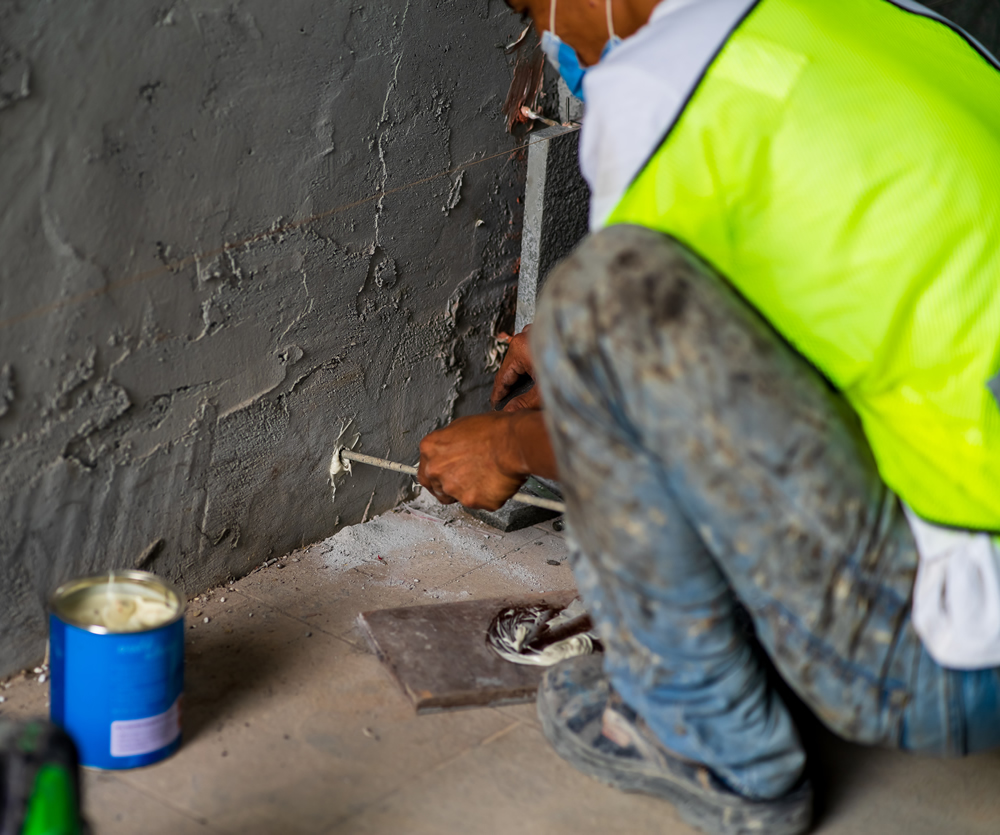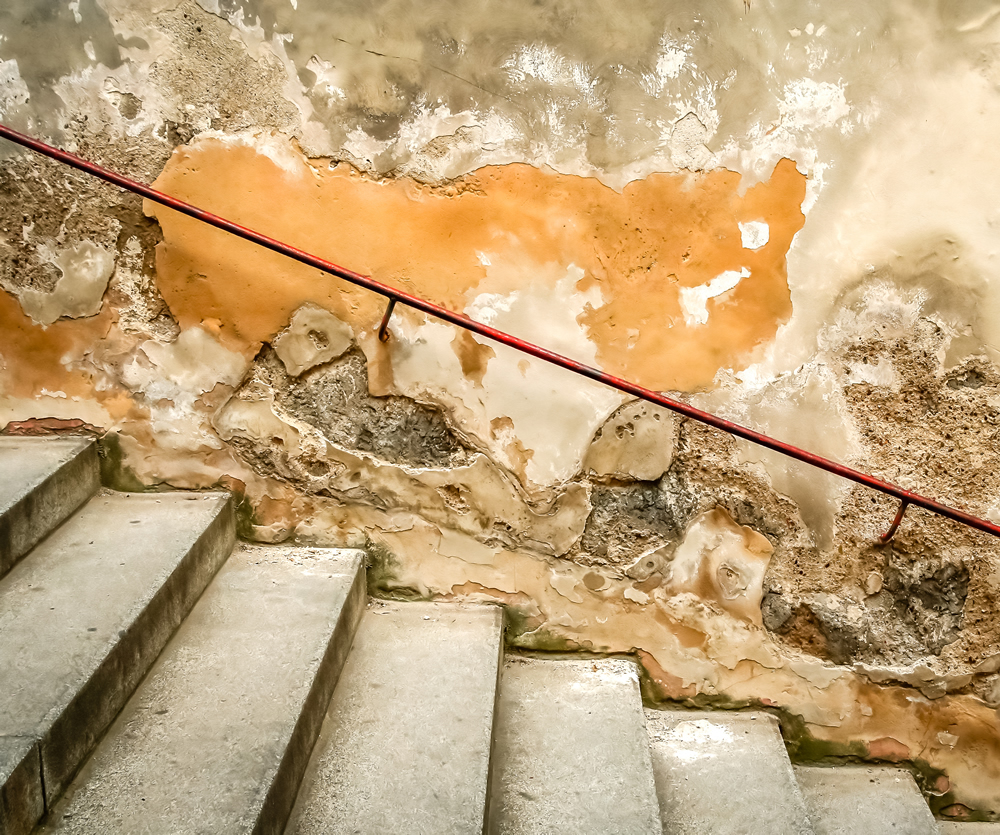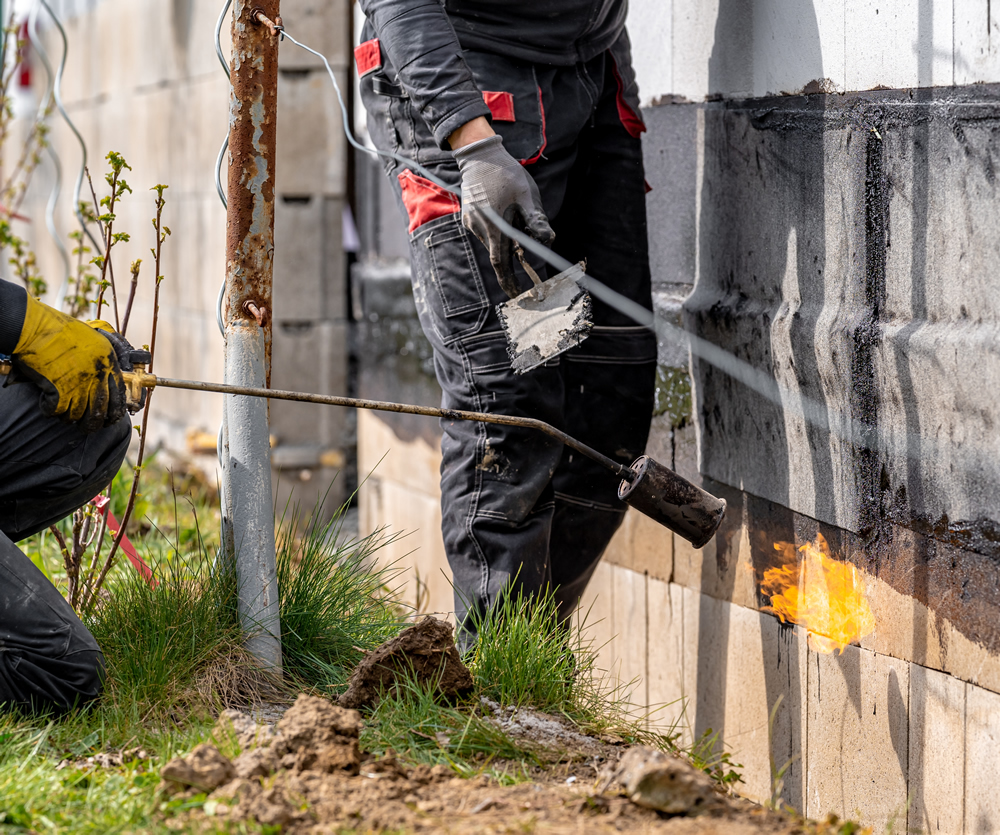Thursday May 2, 2024
What is damp proofing? Damp proofing is an essential protective measure that prevents moisture from entering and damaging the structure of your home. It involves installing barriers in walls and floors, known as the damp proof course (DPC) and damp proof membrane (DPM), to combat various forms of dampness and protect the building’s integrity and indoor air quality. This article explains the necessity of damp proofing, explores its components, and guides you through identifying and resolving damp-related issues.
Key Takeaways
-
Damp proofing is essential for maintaining the structural integrity of properties. It involves methods like installing damp proof courses (DPCs) and damp proof membranes (DPMs) to prevent moisture from rising through masonry or entering from the ground.
-
Properly identifying various damp issues, such as rising dampness, penetrating dampness, and condensation, is crucial before applying targeted treatments. Solutions range from chemical DPC installation to fixing the direct causes of water ingress and implementing measures to prevent condensation.
-
Professional expertise in damp proofing is indispensable, with benefits like accurate diagnosis, adherence to industry standards, and long-term protective solutions that can extend the lifespan of damp-proof systems from 10 to 50 years.
Damp Proofing Decoded: The Essentials
Damp proofing is a broad term used to describe methods and treatments for controlling moisture in walls and floors. Its role is significant in preserving a property’s structural integrity, warding off decay like wet and dry rot, and maintaining the health of occupants. This is particularly crucial in older properties that may not have originally been designed with damp prevention in mind.
Dampness in buildings can originate from various sources, arising either from internal factors or through external penetration. Understanding the different types of dampness and their causes is the first step in effective damp proofing. The two key components of any damp proofing strategy are the damp proof course (DPC) and the damp proof membrane (DPM).
We will examine these two components in greater detail, learning about their roles and contributions to an efficient damp-proofing strategy.

Understanding Damp Proof Course (DPC)
A damp proof course, or DPC, is a treatment applied to walls to prevent water from rising through capillary action in masonry. You can often identify the presence of a DPC by looking for a plastic sheet or black line running horizontally across the brickwork, about 6 inches from the ground. However, a damaged DPC can result from factors such as bridging, deterioration over time, or incorrect installation.
The most common method for installing a damp-proof course is damp-proof injection, which is applicable to both older and newer buildings. While rising dampness is rare and typically impacts older buildings due to failed or non-existent DPCs, newer constructions can also be vulnerable to moisture ingress through elements that bridge the DPC.
The Role of Damp Proof Membrane (DPM)
Like the DPC, a damp-proof membrane (DPM) plays a vital role in damp-proofing. This membrane is specifically designed to prevent moisture from entering a property. It’s commonly placed beneath concrete floors, acting as a barrier to block moisture from penetrating the surface.
While the DPC protects against rising dampness, the DPM shields the property from dampness penetrating from the ground. Together, they form a robust defence against dampness, safeguarding the building and its occupants.
Having clarified the concept of damp proofing and the functions of DPC and DPM, we will discuss the identification and solutions for various damp issues.
Identifying and Addressing Different Damp Issues
A comprehensive evaluation is necessary before installing any damp-proofing products to accurately identify the source and type of dampness. The common types of damp problems encountered in homes are rising damp, penetrating damp, and condensation.
Indications of a damp problem include signs like mould, damp patches, and a musty smell. Rising damp symptoms include a tide mark of dampness up to 1m from the floor, decaying skirting boards, efflorescence, and visible damp patches. On the other hand, symptoms of penetrating damp or condensation usually appear on higher floors.
Being aware of these symptoms is the first step towards addressing damp issues. We will now explore the solutions for each of these damp issues.

Tackling Rising Damp
Rising damp is a form of dampness in walls caused by underground water ascending through the wall fabric. Accurate diagnosis of this damp issue is essential for ensuring appropriate treatment. Indicators of rising damp include:
-
Tide marks
-
Damp stains
-
Peeling wallpaper
-
Salt deposits
-
Deteriorating skirting boards and flooring
To halt rising dampness, you can follow these steps:
-
Establish a new chemical damp proof course (DPC) using tools like Dryzone Damp-Proofing Cream or Dryrod Damp-Proofing Rods. These are designed to impede further moisture ascent.
-
Once a new DPC is installed, affected internal walls may require restoration with damp-resistant plasters.
-
Ensure all contaminated plaster above signs of dampness or salt are removed.
By following these steps, you can effectively stop rising damp and prevent further damage to your damp walls.
Comprehensive treatment of rising damp usually necessitates removing impacted wall materials, repairing or installing DPC, and applying renovating plaster to inhibit salt transfer.
Solutions for Penetrating Damp
Leaks from outside the property often cause penetrating damp. The main solution to protecting the property from this form of dampness is identifying the source of water ingress. The most effective way to resolve penetrating dampness is to fix the underlying cause, such as a damaged roof or leaking pipe, before applying damp-proof treatments.
By addressing the source of the problem directly, the property can be effectively protected from further water penetration, preventing the recurrence of penetrating damp.
Preventing Condensation Problems
The most common cause of dampness in buildings is condensation. It occurs when warm, moist air comes into contact with cold surfaces, leading to the formation of water droplets. It can be prevented by using extractor fans or positive pressure systems and making simple changes to daily activities like drying clothes outside instead of inside.
Implementing these preventative measures after resolving damp issues can influence the overall cost of damp proofing, but the investment is worth it to protect your property from future dampness.
The Environmental Approach to Damp Proofing
Environ Restoration Services offers an array of damp proofing services, such as stone wall restoration, brick repointing, and roofing repairs tailored to preserve the integrity of period properties. This specialist team is known for its professionalism, reliability, punctuality, and integrity, ensuring that clients experience a high level of care and peace of mind in damp-proofing projects.
Moreover, Environ Restoration Services is dedicated to repairing and refurbishing both historical and contemporary buildings in London, melding traditional aesthetics with modern conservation methods. This commitment to quality and preservation sets Environ apart in the field of damp proofing.
The Damp Proofing Process: A Step-by-Step Guide
The damp-proofing process is a systematic one, involving a detailed investigation, application of appropriate damp-proofing treatments, and measures to ensure long-term protection from future dampness. One crucial aspect of this process is the damp proofing course, which ensures efficiency in the application. Clear access to potential problem areas is necessary, which may involve moving furniture and other belongings in preparation for treatment.
We will now dissect this process into its core stages:
-
The initial assessment and damp survey
-
Choice of appropriate damp-proofing solutions
-
Application of damp proofing solutions
-
Aftercare
Each stage is crucial and will be explained in more detail in the following sections.

Initial Assessment and Damp Survey
A specialist with the right expertise, such as a Certified Surveyor in Remedial Treatment (CSRT), is required for an accurate damp diagnosis. The damp survey includes:
-
A detailed visual inspection for signs of dampness like patches and mould
-
Examining the property’s history of damp problems
-
Assessing exterior elements such as the roof and drainage systems
Environ offers property owners a comprehensive damp survey, emphasising the importance of choosing a surveyor with professional certifications such as CSRT or CSSW to ensure the necessary expertise is applied.
Selecting the Right Damp Proofing Solutions
Tailored damp-proofing solutions are formulated after conducting a thorough assessment of the specific type of dampness to choose the most appropriate option that meets the building’s requirements, budget considerations, and material compatibility. Installation of these solutions can vary significantly, from implementing damp-proof membranes to injecting chemical barriers for a damp-proof course or applying waterproofing paints. Integral damp proofing plays a crucial role in ensuring the effectiveness of these damp proofing solutions.
The choice of a damp-proofing methodology is greatly influenced by the nature and severity of the damp issue, ranging from simple repairs for minor problems to comprehensive structural work for more severe cases.
Application and Aftercare
Damp-proofing treatments can involve techniques like applying facade creams, installing damp-proof membranes, or using tanking slurry tailored to address specific damp issues. Following treatment for rising damp, it’s critical to replaster walls to precise specifications to manage saline content and prevent the recurrence of dampness.
Aftercare of damp-proofing includes:
-
Regular inspections and maintenance, such as ensuring proper ventilation
-
Addressing root causes of dampness
-
Periodic reapplication of protective coatings
Professional damp proofing companies, like Cannon Clarke Ltd, offer extensive services, from property surveying to determining the correct treatment solutions and addressing ancillary issues such as dry or wet rot. One crucial aspect they focus on is the existing damp-proof course in the property, which may require remedial damp-proof measures.
Cost Considerations in Damp Proofing
The cost of damp proofing is influenced by the size of the affected area, the severity of the damp issue, and the damp treatment method chosen. It can fluctuate greatly, depending on the severity of the damp problem and the specific treatment needed.
The time to complete damp proofing work, which can impact overall costs, ranges from a single day to a full week, depending on the project scope. Due to a higher likelihood of damp conditions, cellar and basement damp proofing are often quoted per square metre. Confirming the availability of long-term guarantees, which can last for 10 years, and their support by guarantee insurance is crucial when considering the cost implications.
When DIY Isn’t Enough: The Importance of Professional Expertise
While DIY solutions may seem tempting to handle damp issues, professional expertise is often invaluable. Choosing a fully qualified and approved damp proofing firm ensures adherence to the highest industry standards, as evident by membership in the Property Care Association. Relying on experienced damp-proofing companies is key to avoiding misdiagnosis and unnecessary costly treatments.
Although the upfront cost may seem high, professional damp-proofing services provide a cost-effective solution thanks to their skilled assessments and the correct application of treatments. Professional damp proofing services like Cannon Clarke Ltd offer comprehensive solutions, focusing on long-term protection to safeguard your property against future damp issues.
Protecting Your Property: Long-Term Benefits of Damp Proofing
Proper damp proofing serves as both a corrective and a preventative solution to combat moisture-related damage over time. Quality materials and installation can ensure that existing damp-proof systems have a lifespan of 10 to 50 years, safeguarding structures against moisture intrusion for an extended period.
Damp proofing is a long-term investment that contributes to preserving a property’s structural and aesthetic integrity. Overlooking damp proofing could result in serious issues like dry rot and wet rot, jeopardising the property’s strength and safety. So, while the initial cost may be high, the long-term benefits of damp proofing are invaluable in safeguarding your property.
Summary
Damp proofing is more than just a term. It’s a vital process that protects the health of your property and its occupants. Whether it’s understanding the essentials of damp proofing, identifying and tackling different damp issues, or appreciating the comprehensive approach of companies like Environ Restoration Services, we’ve covered it all in this guide.
Remember, damp proofing is not just a corrective measure; it’s a long-term investment that safeguards your property’s structural and aesthetic integrity. So, don’t hesitate to invest in professional damp-proofing services and ensure the well-being of your property and those who call it home.
Frequently Asked Questions
What is damp proofing?
Damp proofing is a method to control moisture buildup in walls and floors, preventing it from seeping into the property.
What are the different types of damp issues?
Rising dampness, penetrating dampness, and condensation are the main types of damp issues in homes.
What services does Environ Restoration provide?
Environ Restoration provides services like brick paint removal, period roofing repairs, and Edwardian house restorations.
How much does damp proofing cost?
Damp proofing costs vary based on factors such as the affected area size, the severity of the issue, and the treatment method chosen.
What is the role of a damp proof course (DPC)?
A damp-proof course prevents water from rising through capillary action in masonry. It is a treatment applied to walls for this purpose.




















